Journal list menu
Export Citations
Download PDFs
EDITORIALS
Clinical trials in the BJD: how to publish, what to publish and where to publish
- Pages: 947-948
- First Published: 21 May 2016
National Institute for Health and Care Excellence melanoma guidelines: good news for patients but challenging to implement
- Pages: 949-950
- First Published: 21 May 2016
Exploring new worlds: expanding the reach of qualitative research in dermatology
- Pages: 951-952
- First Published: 21 May 2016
COMMENTARIES
Interventions for hidradenitis suppurativa: an important step towards evidence-based medicine
- Pages: 953-954
- First Published: 21 May 2016
Linked Article: Ingram et al. Br J Dermatol 2016; 174:970–978.
Actinic keratosis in China: big numbers and small percentages
- Page: 954
- First Published: 21 May 2016
Linked Article: Zhao et al. Br J Dermatol 2016; 174:1005–10.
Of men and mice: analysing the action of an established drug using tumour necrosis factor-α-deficient mice in the imiquimod psoriasis model
- Pages: 955-956
- First Published: 21 May 2016
Linked Article: Vinter et al. Br J Dermatol 2016; 174:1011–1021.
Increasing the diagnostic sensitivity for mucous membrane pemphigoid by detection of salivary autoantibodies
- Pages: 956-957
- First Published: 21 May 2016
Linked Article: Ali et al. Br J Dermatol 2016; 174:1022–1029.
Advice for patients with hair dye allergy remains ‘stop using permanent hair dyes’
- Pages: 957-958
- First Published: 21 May 2016
Linked Article: Kock et al. Br J Dermatol 2016; 174:1042–1050.
Cutaneous lupus erythematosus is strongly associated with psychiatric disease
- Pages: 958-959
- First Published: 21 May 2016
Linked Article: Jalenques et al. Br J Dermatol 2016; 174:1051–1060.
Currently the best treatment for lipoedema
- Pages: 959-960
- First Published: 21 May 2016
Linked Article: Baumgartner et al. Br J Dermatol 2016; 174:1061–1067.
Freely available meteorological data can be used to predict population vitamin D levels
- Page: 960
- First Published: 21 May 2016
Linked Article: Kelly et al. Br J Dermatol 2016; 174:1068–1078.
A prelude to a functional noninvasive in vivo diagnostic tool for skin diseases
- Page: 961
- First Published: 21 May 2016
Linked Article: Gutierrez-Herrera et al. Br J Dermatol 2016; 174:1086–91.
Reviews
SYSTEMATIC REVIEWS
Evidence-based management of vitiligo: summary of a Cochrane systematic review
- Pages: 962-969
- First Published: 21 December 2015
What's already known about this topic?
- Vitiligo is a skin disease with limited treatment options.
- Most of the published vitiligo clinical trials are of poor methodological quality.
What does this study add?
- There are still important variations in study design and outcome measures in vitiligo clinical trials.
- Individual trials showed short-term benefit from topical corticosteroids and various forms of ultraviolet combined with topical preparations.
- Long-term follow-up and patient-rated outcomes should be incorporated into study design, and more studies should assess psychological interventions.
Interventions for hidradenitis suppurativa: a Cochrane systematic review incorporating GRADE assessment of evidence quality
- Pages: 970-978
- First Published: 23 January 2016
What's already known about this topic?
- Many interventions have been tried for hidradenitis suppurativa (HS).
- Evidence supporting the choice of intervention for HS is often limited.
What does this study add?
- Moderate-quality evidence suggests that adalimumab given weekly and infliximab are effective, whereas adalimumab every other week is ineffective.
- There are very limited or no randomized controlled trial data in HS for antibiotic therapy, retinoids, oral immunomodulators or the timing and type of surgery to perform.
Linked Comment: Blok. Br J Dermatol 2016; 174: 953–954
Original Articles
CLINICAL TRIALS
Pulse photodynamic therapy reduces inflammation without compromising efficacy in the treatment of multiple mild actinic keratoses of the face and scalp: a randomized clinical trial
- Pages: 979-984
- First Published: 08 February 2016
What's already known about this topic?
- One important side-effect in photodynamic therapy (PDT) of actinic keratoses (AKs) is post-treatment erythema, which enhances patient down time.
- Corticosteroid use before and just after PDT can reduce treatment-induced erythema.
What does this study add?
- Pulse-PDT (30-min methyl aminolaevulinate, illumination after 3 h) and especially corticosteroid pulse-PDT reduced treatment-induced erythema without affecting the efficacy of the treatment of multiple mild AKs.
- Pulse-PDT and topical corticosteroids may make PDT treatment of large areas more acceptable.
Investigation of selective JAK1 inhibitor GSK2586184 for the treatment of psoriasis in a randomized placebo-controlled phase IIa study
- Pages: 985-995
- First Published: 19 January 2016
What's already known about this topic?
- Inhibition of Janus kinase (JAK) signalling is emerging as an important therapeutic target in the treatment of psoriasis.
What does this study add?
- This study shows that GSK2586184 is efficacious in the treatment of plaque psoriasis over a 12-week period.
- Our results suggest that JAK1 selective inhibition may be an effective treatment option for patients with plaque-type psoriasis, without the laboratory changes seen with broader JAK inhibition.
- Our study details the gene expression profile changes observed in uninvolved and involved skin at baseline and in involved skin after 2 weeks of treatment with GSK2586184.
Plain language summary available online
EPIDEMIOLOGY
Epidemiology of chronic spontaneous urticaria: results from a nationwide, population-based study in Italy
- Pages: 996-1004
- First Published: 12 February 2016
What's already known about this topic?
- Precise information on the epidemiology of chronic spontaneous urticaria (CSU) in Italy is lacking.
What does this study add?
- Annual incidence and prevalence rates of CSU in Italy were calculated from 2002 to 2013 using data from a national database of general practitioners.
- Demographic and clinical determinants associated with the occurrence of CSU were determined.
The prevalence of actinic keratosis in patients visiting dermatologists in two hospitals in China
- Pages: 1005-1010
- First Published: 09 December 2015
What's already known about this topic?
- Actinic keratosis is one of the most common conditions treated by dermatologists in western countries.
What does this study add?
- The overall prevalence of actinic keratoses in patients visiting dermatologists was 0.52% in two hospitals in China, which is much lower than in western countries.
Linked Comment: Wakkee and Nijsten. Br J Dermatol 2016; 174:954
TRANSLATIONAL RESEARCH
Tumour necrosis factor-α plays a significant role in the Aldara-induced skin inflammation in mice
- Pages: 1011-1021
- First Published: 28 November 2015
What's already known about this topic?
- The proinflammatory cytokine tumour necrosis factor (TNF)-α is prevalent in many inflammatory diseases, including psoriasis.
- Not much attention has been given to the role of TNF-α in the frequently used Aldara-induced skin inflammation model.
What does this study add?
- Mice constitutively lacking the expression of TNF-α developed significantly less Aldara-induced skin inflammation compared with wild-type mice, strengthening the importance of the use of this model in the study of psoriasis.
Linked Comment: Kurschus. Br J Dermatol 2016; 174:955–956
Salivary IgA and IgG antibodies to bullous pemphigoid 180 noncollagenous domain 16a as diagnostic biomarkers in mucous membrane pemphigoid
- Pages: 1022-1029
- First Published: 16 December 2015
What's already known about this topic?
- The use of serum to test for specific IgG and IgA autoantibodies to epitopes on bullous pemphigoid antigen II (BP180; collagen XVII) by enzyme-linked immunosorbent assay has been documented.
- Circulating autoantibodies may relate to disease activity and have been reported to be associated with a more severe clinical presentation in mucous membrane pemphigoid (MMP).
What does this study add?
- The study demonstrates for the first time that saliva provides a practical alternative to serum in the diagnosis of MMP as IgG and IgA antibodies to BP180-NC16a can be detected in saliva.
- The detection of secretory IgA antibodies is demonstrated for the first time and indicates local production of autoantibodies to the noncollagenous domain of BP180. This may help provide more insight into the pathogenesis of the disease.
Linked Comment: Schmidt. Br J Dermatol 2016; 174: 956–957
Plain language summary available online
The role of PSMB9 upregulated by interferon signature in the pathophysiology of cutaneous lesions of dermatomyositis and systemic lupus erythematosus
- Pages: 1030-1041
- First Published: 29 December 2015
What's already known about this topic?
- Dermatomyositis (DM) and systemic lupus erythematosus (SLE) have common skin features, including dermal mucin deposition and interferon signature.
What does this study add?
- PSMB9 and versican V1, a core protein for glycosaminoglycan, were upregulated, while type I collagen was downregulated in both DM and SLE skin.
- The interferon signature reduces collagen in dermal fibroblasts of DM and SLE skin, while interferon-induced PSMB9 overexpression induces transforming growth factor (TGF)-β2/β3 in epidermal keratinocytes, which results in versican overexpression in dermal fibroblasts.
- The TGF-β2–ΔDiHS-diS1 pathway is responsible for the specific molecular changes to DM skin.
What is the translational message?
- PSMB9 in the skin of patients with dermatomyositis and systemic lupus erythematosus has great potential as a diagnostic and therapeutic tool.
MEDICAL DERMATOLOGY
Continuous usage of a hair dye product containing 2-methoxymethyl-para-phenylenediamine by hair-dye-allergic individuals
- Pages: 1042-1050
- First Published: 08 January 2016
What's already known about this topic?
- Individuals allergic to para-phenylenediamine (PPD) have shown a lower response rate to forearm testing simulating hair dye use when the hair dye product contained 2-methoxymethyl (ME)-PPD instead of PPD.
What does this study add?
- This study investigates whether PPD-allergic individuals tolerate full hair dyeing with their selected ME-PPD hair dye shade, if they did not respond to forearm pretesting with that hair dye at day 2.
Linked Comment: Pongpairoj et al. Br J Dermatol 2016; 174: 957–958
High prevalence of psychiatric disorders in patients with skin-restricted lupus: a case–control study
- Pages: 1051-1060
- First Published: 08 January 2016
What's already known about this topic?
- No data exist about psychiatric disorders in patients with skin-restricted lupus (SRL).
What does this study add?
- Patients with SRL have a high prevalence of current and lifetime major depressive disorder, generalized anxiety disorder and panic disorder, current suicide risk, alcohol dependence and lifetime agoraphobia.
- Patients with SRL often lack specialized mental health care.
Linked Comment: Bewley. Br J Dermatol 2016; 174:958–959
Plain language summary available online
SURGICAL DERMATOLOGY
Long-term benefit of liposuction in patients with lipoedema: a follow-up study after an average of 4 and 8 years
- Pages: 1061-1067
- First Published: 17 November 2015
What's already known about this topic?
- The longest follow-up studies after liposuction performed in patients with lipo-edema were performed over an average period of 4 years.
What does this study add?
- This study adds new information concerning specific complaints after an average period of 8 years following liposuction in patients with lipoedema.
- These complaints include oedema, spontaneous pain, sensitivity to pressure, bruising, restriction of movement, cosmetic impairment and reduction in quality of life.
Linked Comment: Szolnoky. Br J Dermatol 2016; 174:959–960
Plain language summary available online
GENERAL DERMATOLOGY
The contributions of adjusted ambient ultraviolet B radiation at place of residence and other determinants to serum 25-hydroxyvitamin D concentrations
- Pages: 1068-1078
- First Published: 19 November 2015
What's already known about this topic?
- Solar ultraviolet B (UVB) radiation is the major source of vitamin D (vitD) for humans and it is strongly associated with vitD status.
- UVB radiation at wavelengths that can induce vitD synthesis can be approximated by total UV or UVB radiation, sunshine hours or latitude, typically averaged over a large geographical region and long time period, yielding unreliable approximations.
What does this study add?
- Information on ambient UVB exposure at wavelengths required for vitD synthesis (vitD-UVB), adjusted for cloud cover and ozone layer, is a powerful yet underutilized tool to study the relationships between UVB, vitD and health outcomes.
- There was significant geographical variation in vitD-UVB, even within a small geographical area at a northern latitude.
- Measured ambient vitD-UVB dose at place of residence is a good predictor of vitD status.
Linked Comment: Dawe. Br J Dermatol 2016; 174:960
Plain language summary available online
Dermoscopic clues to differentiate facial lentigo maligna from pigmented actinic keratosis
- Pages: 1079-1085
- First Published: 21 December 2015
What's already known about this topic?
- Dermoscopy is insufficient to differentiate between lentigo maligna (LM) and pigmented actinic keratosis (PAK).
What does this study add?
- White and evident follicles, scales and red colour represent significant diagnostic clues for PAK.
- Intense pigmentation and grey rhomboidal lines appear highly suggestive of LM.
- These novel findings might improve the early detection of LM, while reducing unnecessary biopsies for PAK.
Fluorescence excitation photography of epidermal cellular proliferation
- Pages: 1086-1091
- First Published: 19 January 2016
What's already known about this topic?
- According to the concept of endogenous fluorescence or autofluorescence of skin, certain molecules native to skin fluoresce or emit light upon illumination.
- Endogenous fluorescence has been used as a clinical research method. Fluorescence spectra or maps are acquired by spectroscopy and subsequently correlated to physiology.
What does this study add?
- This study demonstrates the effectiveness of a novel ultraviolet fluorescence excitation photography system in its ability to image rapidly proliferating epidermal skin lesions by capturing endogenous fluorescence emissions.
- The images captured using this method are instantly available and do not require interpretation or reconstruction.
Linked Comment: Youn. Br J Dermatol 2016;174:961
Plain language summary available online
CASE REPORTS
Paediatric necrolytic migratory erythema as a presenting sign of glucagonoma syndrome
- Pages: 1092-1095
- First Published: 20 November 2015
What's already known about this topic?
- Necrolytic migratory erythema often presents as the first clinical sign in glucagonoma syndrome.
- The majority of cases occur in the fifth decade of life, with no paediatric cases previously reported.
What does this study add?
- We present the first reported case of a paediatric patient with necrolytic migratory erythema as the presenting sign of a localized glucagonoma.
- Recognition of necrolytic migratory erythema in patients of all ages can aid in the early diagnosis and treatment of glucagonomas.
Premenstrual flares of pyoderma gangrenosum controlled with use of a combined oral contraceptive and antiandrogen (ethinyl estradiol/drospirenone)
- Pages: 1096-1097
- First Published: 30 November 2015
What's already known about this topic?
- The literature describes a positive role of oestrogen and a negative role of androgens, or androgen receptor activation, in cutaneous wound healing.
- There are reports of premenstrual flares in dermatological conditions such as hidradenitis suppurativa and acne vulgaris.
What does this study add?
- Patients with pyoderma gangrenosum (PG) can have premenstrual PG flares.
- We were able to control our patient's premenstrual PG flares with the use of a combined oral contraceptive and antiandrogen (ethinyl estradiol/drospirenone).
Correspondence
RESEARCH LETTERS
Copy-number variation of the filaggrin gene in Korean patients with atopic dermatitis: what really matters, ‘number’ or ‘variation’?
- Pages: 1098-1100
- First Published: 11 November 2015
Can antioxidant-rich blackcurrant juice drink consumption improve photoprotection against ultraviolet radiation?
- Pages: 1101-1103
- First Published: 19 November 2015
Clinical and dermoscopic characteristics of extramammary Paget disease: a study of 35 cases
- Pages: 1104-1107
- First Published: 19 November 2015
Personal history of psoriasis and risk of incident cancer among women: a population-based cohort study
- Pages: 1108-1111
- First Published: 19 November 2015
Herpes zoster in patients with bullous pemphigoid: a population-based case–control and cohort study
- Pages: 1112-1114
- First Published: 28 November 2015
Pigmented epithelioid melanocytoma: clinical, dermoscopic and histopathological features
- Pages: 1115-1117
- First Published: 28 November 2015
Systemic treatments in childhood psoriasis: a French multicentre study on 154 children
- Pages: 1118-1121
- First Published: 30 November 2015
Marked intrafamilial phenotypic heterogeneity in dystrophic epidermolysis bullosa caused by inheritance of a mild dominant glycine substitution and a novel deep intronic recessive COL7A1 mutation
- Pages: 1122-1125
- First Published: 23 November 2015
Clinical, biophysical and immunohistochemical analysis of skin reactions to acute skin barrier disruption – a comparative trial between participants with sensitive skin and those with nonsensitive skin
- Pages: 1126-1133
- First Published: 23 November 2015
A two-stage treatment of lentigo maligna using ablative laser therapy followed by imiquimod: excellent cosmesis, but frequent recurrences on the nose
- Pages: 1134-1136
- First Published: 30 November 2015
Glove-related hand urticaria: an increasing occupational problem among healthcare workers
- Pages: 1137-1140
- First Published: 27 November 2015
Topical diphencyprone for the treatment of locoregional intralymphatic melanoma metastases of the skin; the 5-year Norwich experience
- Pages: 1141-1142
- First Published: 24 November 2015
Alitretinoin: treatment for refractory palmoplantar keratoderma
- Pages: 1143-1144
- First Published: 30 November 2015
Combination of antitumour necrosis factor-α and anti-interleukin-12/23 antibodies in refractory psoriasis and psoriatic arthritis: a long-term case-series observational study
- Pages: 1145-1146
- First Published: 01 November 2015
LETTERS TO THE EDITOR
Unilateral hyperhidrosis and hypothermia: symptoms of an intrathoracic tumour
- Pages: 1147-1148
- First Published: 26 October 2015
Unique coexistence of cold and solar urticaria and its efficient treatment
- Pages: 1150-1152
- First Published: 18 December 2015
Association of Cole disease with novel heterozygous mutations in the somatomedin-B domains of the ENPP1 gene: necessary, but not always sufficient
- Pages: 1152-1156
- First Published: 30 November 2015
Primary amelanotic rhabdoid melanoma of the forehead
- Pages: 1156-1158
- First Published: 29 December 2015
Correspondence article regarding CD68 as a marker of CD8+ lymphoid proliferation suggested by Wobser et al.
- Pages: 1158-1159
- First Published: 23 January 2016
Delayed oral toxicity from long-term vemurafenib therapy
- Pages: 1159-1160
- First Published: 08 February 2016
IMAGE CORRESPONDENCE
Cover image: Unpeeling the layers of harlequin ichthyosis
- Pages: 1160-1161
- First Published: 21 May 2016
OBITUARY
News and Notices
IMAGE GALLERY
Image Gallery: Cutaneous T-cell lymphoma mimicking a gyrate erythema
- Page: e42
- First Published: 21 May 2016
ABSTRACTS
BSID Annual Meeting, Dalhousie Building, University of Dundee, 4–6 April 2016
- Pages: e43-e74
- First Published: 21 May 2016
PLAIN LANGUAGE SUMMARIES
Plain language summaries
- Pages: e75-e78
- First Published: 21 May 2016
Linked Article: Baumgartner et al. Br J Dermatol 2016; 174:1061–1067.
Linked Article: Kelly et al. Br J Dermatol 2016; 174:1068–1078.
Linked Article: Ali et al. Br J Dermatol 2016; 174:1022–1029.
Linked Article: Jalenques et al. Br J Dermatol 2016; 174:1051–1060.
Linked Article: Ludbrook et al. Br J Dermatol 2016; 174:985–995.
Linked Article: Gutierrez-Herrera et al. Br J Dermatol 2016; 174:1086–91.
Plain language summaries in Simplified Chinese
- Pages: e79-e81
- First Published: 21 May 2016
Linked Article: Baumgartner et al. Br J Dermatol 2016; 174:1061–1067.
Linked Article: Kelly et al. Br J Dermatol 2016; 174:1068–1078.
Linked Article: Ali et al. Br J Dermatol 2016; 174:1022–1029.
Linked Article: Jalenques et al. Br J Dermatol 2016; 174:1051–1060.
Linked Article: Ludbrook et al. Br J Dermatol 2016; 174:985–995.
Linked Article: Gutierrez-Herrera et al. Br J Dermatol 2016; 174:1086–91.




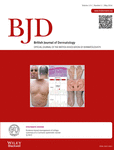

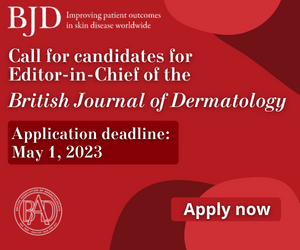
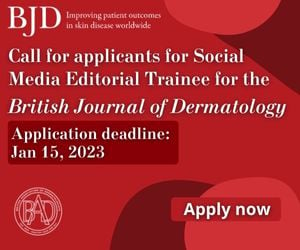

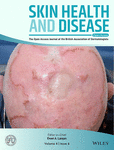
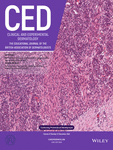
2690-442X.cover.png)